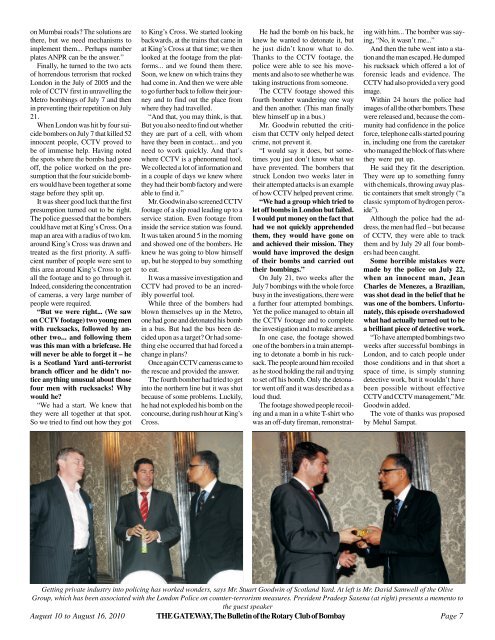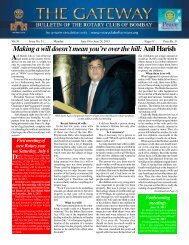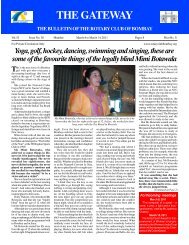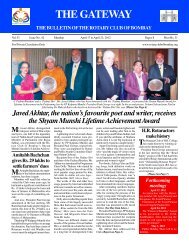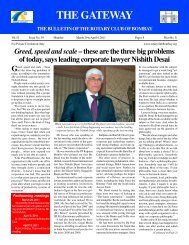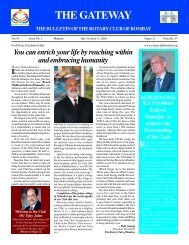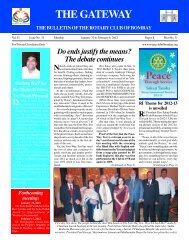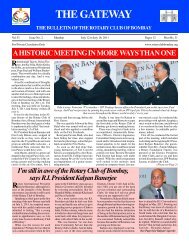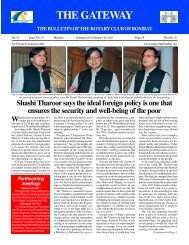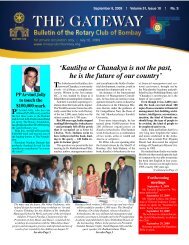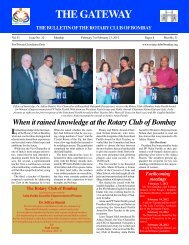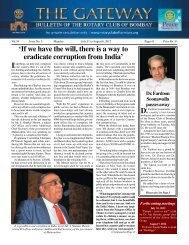‘NOT ONLY POLICE, EVEN THE PUBLIC BELIEVESTHAT CCTV CAMERAS ARE A VERY POWERFUL TOOL’(Continued from Page 2)India, on the other hand, with 20%of the world population, had a CCTVcamera density that was not worthwriting home about.“But how did a small country likethe UK come to possess so many cameras?It was actually an accident, likemany things that happen in the UK...”The first time that a camera caughtcrime in the course of public spacesurveillance in the UK was in Scotlandin the days of light-sensitivepaper that required hours if not daysto develop a photograph. One picturehad caught someone stealing ahandbag. Things got going only in the1970s.As the consumption of alcoholincreased on Friday and Saturdaynights, there was behaviour of thetype not normally seen in decentLondon with its huge African Caribbeanpopulation.CCTV images taken in Brixton andshown on the news helped nab theman even as he was planting a bomb.The public soon started to believethat CCTVs were quite a powerfultool<strong>Of</strong> course, there were those whohad problems such as people workingfor civil liberties and so on. Butall of them were forced to hold theirfire because the new tool was cominginto vogue at a time when the countrywas dealing with Irish terrorism.“The word terrorism is often usedto stifle public debate – and I wouldsay that as a counter-terrorism officer.Terrorism is an awful thing andno one knows that better than theresidents of Mumbai, but it shouldn’tbe used as something that stifles publicthe cameras that seem to be everywhere.“A lot of it is farmed out to theprivate sector, which again creates aproblem when we try to ‘harvest’ theimages, or to find the cameras, becausethe private sector is not regulated;it goes about changing cameras,moving them or taking them downwithout informing us. Every timesomething happens, we have to goout afresh and identify where thecameras are, who owns them andwhere the images are being stored.”Mr. Goodwin claimed that the generalpublic in the UK was not worriedabout CCTV. It believed that ifone had nothing to hide, then therewas nothing to worry. But the publiconly looked at things in black andwhite; it never mulled over or debatedissues in detail.some inappropriate behaviour, wasgoing on.The authorities had stepped in recentlyand camera operators werenow being regulated. They had tohave a certification in order to dopublic space surveillance.Mr. Goodwin next referred toANPR or Automatic Number PlateRecognition which was being usedwith increasing frequency. It automaticallypicked out the registrationplates on cars and checked themagainst police and other data bases. Ifan agency had any concerns, it couldask the CCTV providers with ANPRto look for certain cars. Although thissystem was invented in 1976, the firstarrest of a person driving a stolen carwas recorded in 1981 in Dartford inKent.And now, after wasting a lot ofsocieties. Such anti-socialdebate about some very serious Since the police did not monitor time, money and energy, the Met-behaviour was becoming a problemin the cities and, when combinedwith other crimes such asthefts from cars, burglaries and soon, someone thought about installingcameras so that the revellerscould be monitored.When the Home <strong>Of</strong>fice made grantsavailable to local authorities to suggestsolutions, they came up withsome very good business cases. Suddenly,CCTV systems financed bythe Home <strong>Of</strong>fice were springing upall over the UK.However, they made an impactonly in 1993 following the murder ofa two-year-old boy, Jamie Bolger,who was with his mother in a shoppingcentre in the north of England.Two ten-year-old boys managed tolead him away when his motherwasn’t paying attention. The CCTVfootage showed one of the boys leadingJamie by the hand out of the shoppingcentre.Mr. Goodwin said that the boyswent on to murder the child on a railwaytrack. The CCTV images wereforced on the public consciousnessand led to the capture and prosecutionof the two boys.There were a few other cases, too,such as that of David Copeland whowas “a loner, a right-wing extremistwho hated everybody who was differentissues.“What many people don’trealise is that of all the cameras,very few are controlled by the policethemselves. Even in the secureareas of London where theseats of governance are located,there are very few cameras monitoredby the police. They are monitoredby private industry and localauthorities... we ourselvesdon’t have the people to monitorthe cameras, it had no control overthem or over the individuals sitting inrooms and monitoring them whileworking for private companies. A recentuniversity study had shown thatsome of these individuals spent theirtime looking at inappropriate things.Those most likely to be zoomedin and filmed were attractive womenand coloured people of both genders.There were some issues involved inthis and some discrimination, as alsoropolitan Police had finally concludedthat if it wanted effectivesystems, it had to get people whoknew what they were doing andwho could devote their energiesto think of solutions and the bestways to implement them. The policehad finally started using privateindustry.“I have here (in the audience) acolleague from the Olive Group (Mr.David Samwell) which records all thetraffic going into London throughANPR systems; it’s an incrediblyeffective tool and was brought in aftera considerable spate of bombingsby the IRA. If the police use industry,then you can really get thingsgoing.“Some of the issues that I talkedabout, about the cameras being everywhereand not being regulated... ifyou use industry properly and givethem a tight brief of what you aretrying to achieve, you can workagainst those issues and make surethat you are using your cameras forthe purpose you have in mind.“We are now sitting down and talkingto the community. We don’t haveall the answers... we tell them thatwe can give you a police state, butwe’re sure you don’t want that. Sowhat are the levels that society willtolerate? We have to find out.”from himself”; he carried out a In spite of the plethora of cameras in the UK, very few are controlled by the Mr. Goodwin then took a light digseries of attacks, in Bricklane in the police themselves. Even in the secure areas of London where the seats of at the traffic situation in <strong>Bombay</strong> andeast end of London (a predominantly governance are located, there are very few cameras monitored by the suggested the introduction of laneAsian area), in a Soho bar for gay police. They are monitored by private industry and local authorities, discipline as in London. “Whypeople and in Brixton in the south ofreveals Mr. Stuart Goodwindoesn’t somebody paint white linesAugust 10 to August 16, 2010 THE GATEWAY, The Bulletin of the <strong>Rotary</strong> <strong>Club</strong> of <strong>Bombay</strong> Page 6
on Mumbai roads? The solutions arethere, but we need mechanisms toimplement them... Perhaps numberplates ANPR can be the answer.”Finally, he turned to the two actsof horrendous terrorism that rockedLondon in the July of 2005 and therole of CCTV first in unravelling theMetro bombings of July 7 and thenin preventing their repetition on July21.When London was hit by four suicidebombers on July 7 that killed 52innocent people, CCTV proved tobe of immense help. Having notedthe spots where the bombs had goneoff, the police worked on the presumptionthat the four suicide bomberswould have been together at somestage before they split up.It was sheer good luck that the firstpresumption turned out to be right.The police guessed that the bomberscould have met at King’s Cross. On amap an area with a radius of two km.around King’s Cross was drawn andtreated as the first priority. A sufficientnumber of people were sent tothis area around King’s Cross to getall the footage and to go through it.Indeed, considering the concentrationof cameras, a very large number ofpeople were required.“But we were right... (We sawon CCTV footage) two young menwith rucksacks, followed by anothertwo... and following themwas this man with a briefcase. Hewill never be able to forget it – heis a Scotland Yard anti-terroristbranch officer and he didn’t noticeanything unusual about thosefour men with rucksacks! Whywould he?“We had a start. We knew thatthey were all together at that spot.So we tried to find out how they gotto King’s Cross. We started lookingbackwards, at the trains that came inat King’s Cross at that time; we thenlooked at the footage from the platforms...and we found them there.Soon, we knew on which trains theyhad come in. And then we were ableto go further back to follow their journeyand to find out the place fromwhere they had travelled.“And that, you may think, is that.But you also need to find out whetherthey are part of a cell, with whomhave they been in contact... and youneed to work quickly. And that’swhere CCTV is a phenomenal tool.We collected a lot of information andin a couple of days we knew wherethey had their bomb factory and wereable to find it.”Mr. Goodwin also screened CCTVfootage of a slip road leading up to aservice station. Even footage frominside the service station was found.It was taken around 5 in the morningand showed one of the bombers. Heknew he was going to blow himselfup, but he stopped to buy somethingto eat.It was a massive investigation andCCTV had proved to be an incrediblypowerful tool.While three of the bombers hadblown themselves up in the Metro,one had gone and detonated his bombin a bus. But had the bus been decidedupon as a target? Or had somethingelse occurred that had forced achange in plans?Once again CCTV cameras came tothe rescue and provided the answer.The fourth bomber had tried to getinto the northern line but it was shutbecause of some problems. Luckily,he had not exploded his bomb on theconcourse, during rush hour at King’sCross.He had the bomb on his back, heknew he wanted to detonate it, buthe just didn’t know what to do.Thanks to the CCTV footage, thepolice were able to see his movementsand also to see whether he wastaking instructions from someone.The CCTV footage showed thisfourth bomber wandering one wayand then another. (This man finallyblew himself up in a bus.)Mr. Goodwin rebutted the criticismthat CCTV only helped detectcrime, not prevent it.“I would say it does, but sometimesyou just don’t know what wehave prevented. The bombers thatstruck London two weeks later intheir attempted attacks is an exampleof how CCTV helped prevent crime.“We had a group which tried tolet off bombs in London but failed.I would put money on the fact thathad we not quickly apprehendedthem, they would have gone onand achieved their mission. Theywould have improved the designof their bombs and carried outtheir bombings.”On July 21, two weeks after theJuly 7 bombings with the whole forcebusy in the investigations, there werea further four attempted bombings.Yet the police managed to obtain allthe CCTV footage and to completethe investigation and to make arrests.In one case, the footage showedone of the bombers in a train attemptingto detonate a bomb in his rucksack.The people around him recoiledas he stood holding the rail and tryingto set off his bomb. Only the detonatorwent off and it was described as aloud thud.The footage showed people recoilingand a man in a white T-shirt whowas an off-duty fireman, remonstratingwith him... The bomber was saying,“No, it wasn’t me...”And then the tube went into a stationand the man escaped. He dumpedhis rucksack which offered a lot offorensic leads and evidence. TheCCTV had also provided a very goodimage.Within 24 hours the police hadimages of all the other bombers. Thesewere released and, because the communityhad confidence in the policeforce, telephone calls started pouringin, including one from the caretakerwho managed the block of flats wherethey were put up.He said they fit the description.They were up to something funnywith chemicals, throwing away plasticcontainers that smelt strongly (“aclassic symptom of hydrogen peroxide”).Although the police had the address,the men had fled – but becauseof CCTV, they were able to trackthem and by July 29 all four bombershad been caught.Some horrible mistakes weremade by the police on July 22,when an innocent man, JeanCharles de Menezes, a Brazilian,was shot dead in the belief that hewas one of the bombers. Unfortunately,this episode overshadowedwhat had actually turned out to bea brilliant piece of detective work.“To have attempted bombings twoweeks after successful bombings inLondon, and to catch people underthose conditions and in that short aspace of time, is simply stunningdetective work, but it wouldn’t havebeen possible without effectiveCCTV and CCTV management,” Mr.Goodwin added.The vote of thanks was proposedby Mehul Sampat.Getting private industry into policing has worked wonders, says Mr. Stuart Goodwin of Scotland Yard. At left is Mr. David Samwell of the OliveGroup, which has been associated with the London Police on counter-terrorism measures. President Pradeep Saxena (at right) presents a memento tothe guest speakerAugust 10 to August 16, 2010 THE GATEWAY, The Bulletin of the <strong>Rotary</strong> <strong>Club</strong> of <strong>Bombay</strong> Page 7


